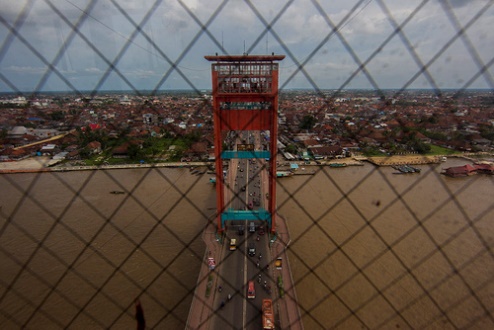The transportation sector is the largest contributor to pollution in urban areas. Research conducted by the Ministry of environment (MOE) and put the database in 2010 shows, transport contributes to 50 to 70 percent of the total emissions of fine particles and 75 percent of total harmful greenhouse-gas emissions to health. While emissions of greenhouse gases (GRK) of the transportation sector in urban areas is about 23 percent of the total GRK emissions from all sources.
Deputy of environment pollution control, MOE, M.R. Kaliansyah explained that the growth of vehicles in Indonesia is getting serious. “At this time, there is nine million units addition of motor vehicles every year throughout Indonesia. This amount is a challenge, we are targeting to reduce emissions to the level of 0.33 tCO2/capita/year by 2050,” he said in Jakarta, Friday (27/6).
To offset the rapid growth, the Government set two cities Palembang and Surakarta as the pilot area of Ecofriendly Transport Programmes and sustainable also known as Environmental Sustainable Transportation (EST). Until 2013, the early stages of EST, in the form of an inventory has been completed with details: Palembang 0.5 tCO2/capita/year and Surakarta 1.2 tCO2/capita/year.
“The number obtained will be the basis of development data EST model. Besides, regional government can also use it as a guideline in the preparation of City’s Air Action Plans are aligned with the Medium-term of Regional Development Plan or RPJMD,” said Novrizal Tahar, MOE’s Deputy assistant of Mobile Source Air Pollution Control.
The success of Palembang and Surakarta make Governments in six other areas to use the same concept. That cities are Batam, Yogyakarta, Surabaya, Malang, Denpasar, and Banjarmasin. Interestingly, these three areas in 2014: Bandung, Medan and Tangerang stated a commitment to calculate emissions independently through Revenue and Expenditure Budgets (APBD).
See this enthusiasm high enough, the Ministry of Transportation (Kemenhub) stated that currently preparing a ministerial regulation as the basis for the implementation of EST. “This Regulation Minister of Transportation Regulation will become the legal basis implementation of EST which includes program implementation in the town or village covers road, rail, sea, and air transport modes. We try so it can be ratified this year,” said Elly A Sinaga, Head of research and development of the Ministry of transportation.
Meanwhile, the Clean Air project Advisor for Smaller CitieS – GIZ, Anissa S. Febrina, who provides technical support EST on MOE, explains that the measurement of emissions in the area of using primary data. “Cost to each is 400 million dollars. Is very small compared to APBD, especially when seen from the advantages gained. Regions could compose RPJMD or renstra sectoral in more measured and directed,” she said.
Anissa added that EST carried by GIZ in several countries focusing on ecofriendly public transport. She illustrates, to such a level of success in China is relatively easy because the centralized governance. Other examples of success seen in Bogota, Colombia where Bus Rapid Transport policy into a model by many of the world’s metropolis, including Jakarta. Azhari Fauzi.
